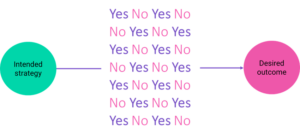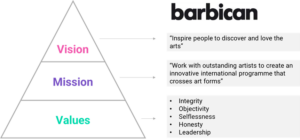
Beginner Read Digital Strategy
An effective digital strategy can be vital to your organisation’s success. Read on to understand the key considerations when developing yours.
In this article
One of the main reasons a digital strategy can help creative and cultural organisations and individuals is that simply having a strategy will improve your chances of success, in whatever it is you set out to achieve.
Simply put, a strategy is a set of decisions that you either say Yes or No to. It is a high-level plan that details the choices you are going to have to make to get to a desired outcome.

These choices, therefore your strategy, will be different for EVERY organisation or individual. A digital strategy is heavily influenced by external influences, such as political or economic change that organisations and individuals must consider if the design of the strategy is to be achievable and sustainable. In the past few years there have been many unexpected bumps in the road, particularly felt within the creative and cultural sector, meaning that good decision-making through careful strategic planning is more important than ever.
Here are 5 compelling reasons why you, or your organisation, should be putting a digital strategy at the top of your priority list.
Without knowing the destination, you cannot plan a route to get there. An organisation’s or individual’s vision is its guiding beacon. The vision is an aspirational statement that describes your long-term objective and the impact you want to have on the world. Communicated well, an organisations vision is a powerful device for coordinating efforts towards a desired outcome or set of objectives.
A vision statement is typically made up of 3 parts: the vision, a mission statement that outlines how you intend to realise the vision, and a list of core values or commitments that underpin your actions and messaging. Here is Barbican’s artistic vision statement… but what’s yours?

IMAGE DESCRIPTION: Barbican’s artistic vision
So, what’s the strategy part? The strategy links your objectives to your current reality. Your strategy is the action plan that is relevant and advantageous in current conditions. It answers the question, “How we are going to get from A-B?”.
We now know that your objectives shape your strategy and your strategy designs the action. But how will a digital strategy improve your chances of success?
A strategy provides you with a framework: A digital strategy helps you prioritise the key steps you need to take to reach your objective(s). A coherent plan will guide the way you and your team do things on a daily basis (e.g. processes, actions, and routines), and helps to get everyone on the same page, resulting in better allocation of time, resources, skills, technology, and the list goes on…
A strategy will provide you with tactics: A well-designed digital strategy will help you to identify opportunities that will drive your tactics. Tactics are short-term activities that leverage current opportunities and can be executed within your existing capabilities.
A strategy gives you an advantage: By design, developing strategies help you to reveal your strengths and weaknesses. A well considered plan for how you will reach your goals allows you to focus on capitalising on your strengths and turning them into an advantage that makes you more unique, giving audiences a greater reason to choose you ahead of your competitors.
Spending time to develop a marketing strategy will help you to ensure you’re taking everything into account and avoiding costly mistakes. A good strategy identifies the challenges that must be overcome and designs a way to overcome it, which in turn reduces the risk of failure. A bad strategy fails to identify what the challenges are. Some common examples of bad strategic planning include:
Two important tools for identifying challenges to your organisation on a macro and micro scale are:
PEST Analysis – a zoomed-out view of an organisation’s or individual’s external influences. It helps to identify and predict future risks that are necessary to inform strategic decision-making.
SWOT Analysis – an internal assessment of your strengths and weaknesses. When in combination with PEST analysis, it is a great way to highlight gaps and opportunities in the market from all angles.

PEST and SWOT analyses help decision makers create sustainable and actionable goals. When creating goals, write them down first. Think about the disadvantages you’ve had (weaknesses). Next, come up with other solutions to reach this goal (opportunities). Finally, identify the blockers that are preventing you from reaching this goal (threats). Once you’re done, read back through your notes. Think. Reflect. And create a plan to reach these goals where you can limit weaknesses, capitalise on opportunities, and avoid threats.
Ideally, PEST and SWOT analyses should be conducted on a regular basis. This is plainly demonstrated when considering the proposed policy changes to the post-Brexit Data Reform Bill in the UK. If plans get approved by the government, it will affect everyone that uses the internet. No matter how big or small your organisation is, you will be required to make changes to your website by law – resulting in having to invest time, money, and resources just to have a legal website. Nothing has been confirmed yet, but one to keep a close eye on! For more information on what’s been proposed in the draft Data Reform Bill, head over to Heather Burn’s article Pop-ups are Dead, long live pop-ups.
To end this section, I feel it’s necessary to reiterate that regular monitoring and reviewing of market forces, using tools like PEST and SWOT analyses, will allow you to stay more relevant and be much better prepared if unexpected change happens. These days, it’s a given.
First, you need to know how you or your organisation ‘shapes up’ before you can make plans and choose tactics that will work for you. One way to achieve this is through market research – the process of identifying factors that could help you or hurt you. Ultimately, the aim is for you to understand your true value in the eyes of the people that matter, so that you can attract and retain audiences more effectively.
Market research methods can vary widely depending on what you’re trying to learn about. For example, competitor analysis is a great way to understand what the competition around you looks like so that you can compare, contrast, and stay relevant in the marketplace. Here is a great introduction to competitor analysis by the guys at Asana – How to Create a Competitive Analysis.
However, if you want to learn what it is that really makes you valuable, going through the below steps for each of your audience segments will start to unlock your value proposition:
NB: If you have multiple audiences, repeat the above steps for each segment.
Once you have gone though the steps above, identified the key areas of value to your audiences, and made assumptions on how you can optimise these areas, you will be in a great position to create a potent strategy. You will have gained:

IMAGE DESCRIPTION: A matrix is a useful tool for visualising where you fit within a set of conditions. In this example, the X-axis represents customer satisfaction, while the Y-axis represents market share.
Efficiency is the ability to get the most output from the least possible input. It basically means doing less but achieving more. With a coherent and coordinated strategy in place, you will be able to set goals that keep everyone and everything aligned with your business objective(s).
SMART goals, as outlined in the image below, are the key to executing a successful digital strategy. They form the day-to-day actions that keep everyone on track and with one eye on the bigger picture. Smart, measurable, attainable, realistic, and timely goals, break down wider objectives and chunk them into manageable jobs with tangible outcomes. And it’s creating these ‘bite-sized jobs’ that go a long way to increasing overall efficiency. Here are a few examples:
 IMAGE DESCRIPTION: Specific, measurable, attainable, realistic, and timely goals.
IMAGE DESCRIPTION: Specific, measurable, attainable, realistic, and timely goals.
This article aims to provide compelling reasons why creative and cultural organisations and individuals should continue to put emphasis on digital strategy so that they can adapt to change and drive better results online. By investing time to create a strategic framework for your organisation, a common language that all members subscribe to, your organisation will become more resilient in turbulent times and thrive when times are more forgiving.
If you are not sure what your digital strategy might look like? Reach out to the Digital Culture Network and we can help you to design custom, strategies tailored to your business goals. We would love to talk!
A good strategy:
The Digital Culture Network is here to support you and your organisation. Our Tech Champions can provide free 1-2-1 support to all creative and cultural individuals and organisations who are in receipt of, or eligible for, Arts Council England funding. If you need help or would like to chat with us about any of the advice we have covered above, please get in touch. Sign up for our newsletter below and follow us on Twitter @ace_dcn and LinkedIn for the latest updates.
Beginner Read Digital Strategy
An effective digital strategy can be vital to your organisation’s success. Read on to understand the key considerations when developing yours.
Beginner Read Digital Marketing
Five recommendations to help improve your digital marketing performance.
Beginner Read Digital Strategy
Do you have a good understanding of which parts of your digital strategy are working? Our diagnostic will help you assess and improve your activities.
Intermediate Read Digital Strategy
Do you often find yourself juggling 10 different tasks at once? Do you find you are not doing things as well as you know you could? This article will help you to streamline your marketing and redirect focus towards feasible and sustainable goals.
Beginner Read Data Analytics and Insight Digital Marketing
Excel is arguably the most powerful software at sorting data into meaningful categories and the go-to tool for most marketers and data analysts, particularly when it comes to reporting. This article will introduce you to ten functions, formulas and shortcuts to try next time you are manipulating your metrics.
Beginner Read Digital Marketing Digital Strategy Social Media
Writing a landing page headline in 6 to 12 words is not as simple as it first appears but there is a straightforward process you can follow to move from a poor-performing headline, to one that performs. Read on to learn about the key steps you should consider following to optimise your landing page headlines.




